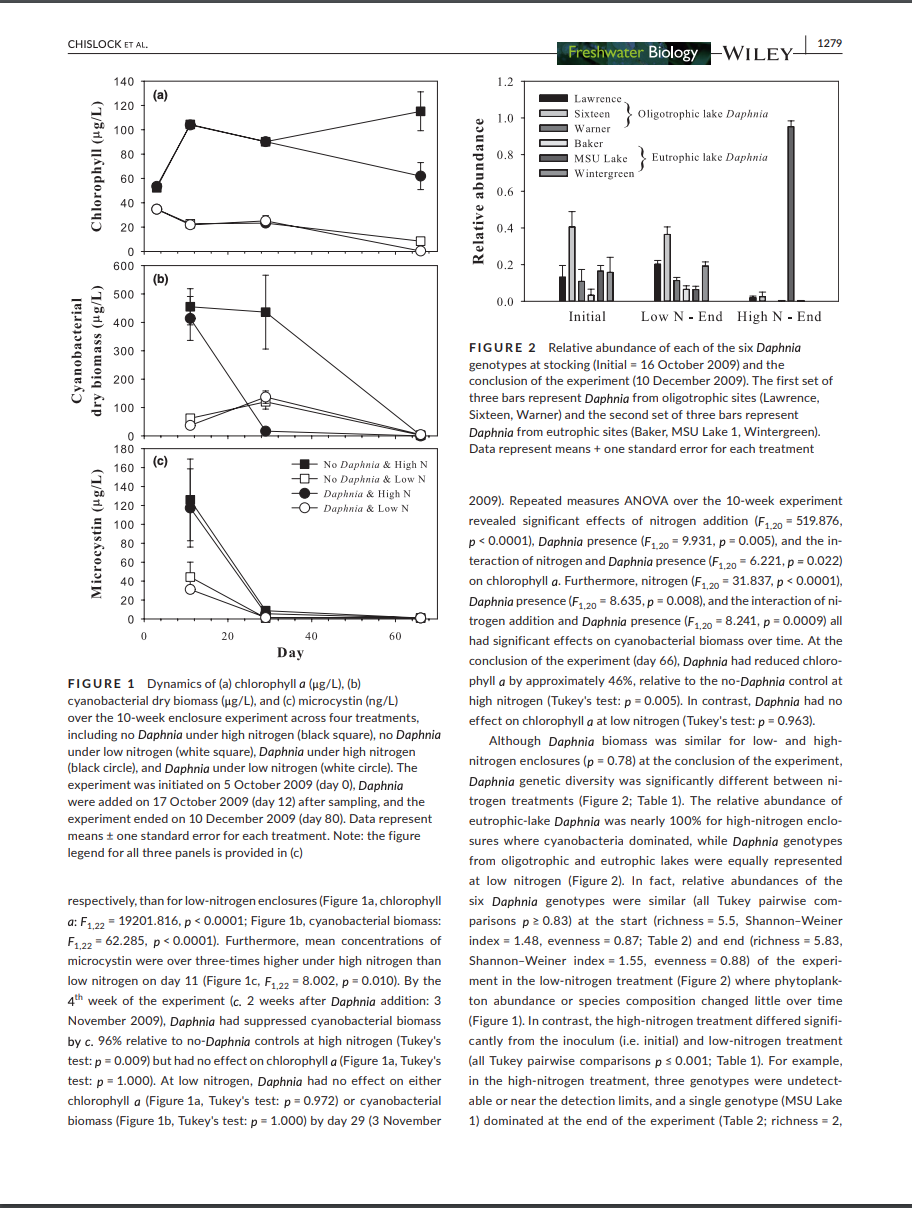Keyword: ecological stoichiometry

Chislock, M. F., R. B. Kaul, K. A. Durham, O. Sarnelle, and A. E. Wilson. 2019. Eutrophication mediates rapid clonal evolution in Daphnia pulicaria. Freshwater Biology 64:1275-1283.
Abstract
- Laboratory studies have revealed that Daphnia species can evolve to tolerate toxic cyanobacteria in the diet. Specifically, Daphnia from eutrophic lakes where cyanobacteria are common tend to have higher growth rates and survival when fed toxic cyanobacteria than populations from oligotrophic environments with low abundance of cyanobacteria.
- We conducted an in‐lake mesocosm (i.e. limnocorral) experiment during the autumn of 2009 to assess the effects of nutrient enrichment on clonal evolution in Daphnia pulicaria. As nutrient enrichment often favours grazing‐resistant cyanobacteria, we hypothesised that fertilisation would influence the genotypic composition of D. pulicaria that vary in tolerance to cyanobacteria. Mesocosms were fertilised to manipulate phytoplankton and cyanobacterial abundance and concentrations of a cyanobacterial toxin (microcystin). Thus, half of the mesocosms were high‐nutrient and half were low‐nutrient. We then stocked half of the mesocosms with a mixture of six genetically‐distinct D. pulicaria genotypes (three genotypes from oligotrophic lakes and three from eutrophic lakes) leaving half of the mesocosms Daphnia‐free to assess grazing effects, using a fully factorial design.
- When compared to the low nutrient treatment, high nutrient mesocosms had nearly five‐fold higher chlorophyll a concentrations, eight‐fold higher cyanobacterial dry biomass, and three‐fold higher microcystin levels at the start of the experiment. In contrast, low nutrient mesocosms had phytoplankton concentrations typical of mesotrophic lakes.
- Fertilisation strongly affected Daphnia genetic diversity in the mesocosms. Final Daphnia genotype diversity in the mesocosms with low‐cyanobacteria (richness = 5.83, Shannon–Weiner index = 1.55, evenness = 0.88) was similar to the initial stocked diversity (richness = 5.50, Shannon–Weiner index = 1.48, evenness = 0.87). In contrast, final diversity in fertilised mesocosms with high cyanobacteria was greatly reduced (richness = 2, Shannon–Weiner index = 0.17), with one Daphnia genotype that originated from the most‐eutrophic lake being highly dominant (evenness = 0.25). Thus, eutrophication mediated strong clonal selection of a cyanobacteria‐tolerant Daphnia genotype over just 10 weeks.
- By the end of the experiment, Daphnia significantly reduced phytoplankton biomass in the high‐nutrient, but not in the low‐nutrient treatment. This difference in effect size was largely driven by the five‐fold higher initial phytoplankton biomass in the high‐nutrient treatment. Thus, the ability of Daphnia to reduce phytoplankton biomass in eutrophic lakes may be driven more so by the abundance of planktivorous fishes, as opposed to the prevalence of cyanobacteria and their associated toxins.